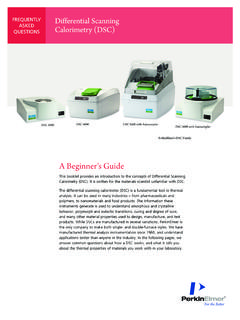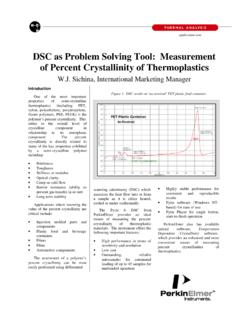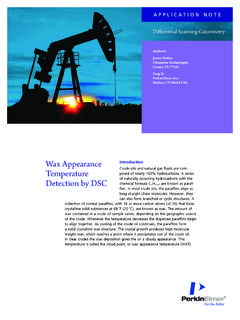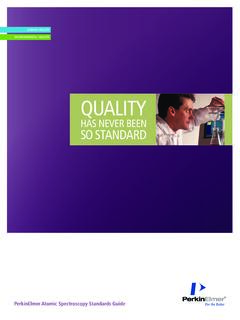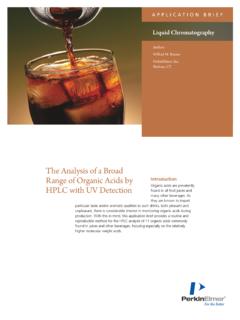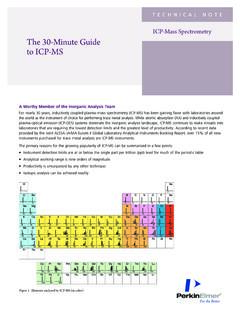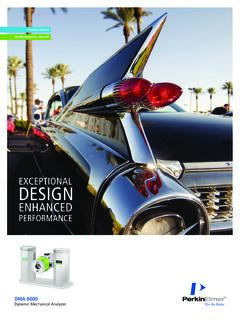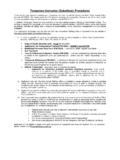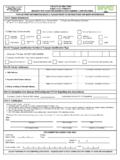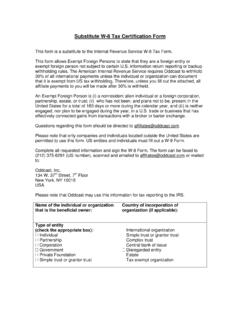Transcription of Why System Suitability Tests Are Not a Substitute …
1 WhitepaperSystem Suitability Tests and phDPrincipal, McDowall Consultingpaul SmithEuropean Validation Program Manager, PerkinElmerNicola Vosloo phD European Market Development Leader, PerkinElmer PurposeThis white paper discusses the role of System Suitability Tests (SSTs) in the context of Analytical Instrument Qualification (AIQ) and is based upon the United States Pharmacopoeia (USP) general chapter 1058 on AIQ[1]. We will discuss why SSTs are not a Substitute for AIQ for the initial qualification or re-qualification ( a periodic, typically annual Operational Qualification) of an There is a common misconception in some regulated laboratories that System Suitability Tests (SSTs) can be used to qualify an instrument. This is wrong. Furthermore using SSTs as the sole instrument qualification approach will leave any laboratory exposed to regulatory action as the instruments and systems cannot be demonstrated as being fit for their intended <621>[2] and European Pharmacopoeia (EP) chapter [3] have both specified requirements for SST for chromatographic analysis to demonstrate that a chromatograph is fit for the analysis it will undertake on the day of analysis.
2 System Suitability Tests are run each time an analysis is undertaken and each SST is specific for an individual method with pre-defined acceptance criteria precision, peak shape and resolution from other analytes. If an SST fails, then the samples cannot be assayed. The principle of a point of use check, such as an SST, is applicable to any analytical instrument or System and this is performed just before an analysis to demonstrate correct performance a check weighing for an analytical balance or a scanning a known standard for an NIR identity check. Although this white paper is written primarily from the perspective of Good Manufacturing Practice (GMP) regulations and the USP <1058> general chapter on AIQ, the content is good analytical science and applicable to all laboratories.
3 Why System Suitability Tests Are Not a Substitute for Analytical Instrument Qualification 2An Overview of USP <1058>: Analytical Instrument QualificationThe general chapter on AIQ (USP <1058>) comprises six major sections: Components of data quality Analytical instrument qualification process Roles and responsibilities Software validation Change control Instrument categories The key sections from USP <1058> that concern our debate of AIQ versus SST are the components of data quality and the analytical instrument qualification process. USP <1058> quotations used in this white paper come from these two sections. Understanding the Data Quality TriangleThe first major section of USP <1058> is entitled 'Components of Data Quality'. This discusses the four layers, presented in the form of a triangle.
4 Throughout this white paper we will refer to this as the data quality triangle and this is shown in Figure 1. The purpose of the data quality triangle is to ensure that data quality is ensured with the proper application of these four areas: Analytical Instrument Qualification (AIQ) Analytical Method Validation System Suitability Tests Quality Control Check SamplesThis approach is applicable to all laboratories regardless of whether they operate in a regulated or quality environment as it describes good analytical science as well as good business by protecting the investment. How many of you would dare ask your manager to buy an instrument that was not fit for purpose? Yet, if you do not satisfy the four layers of <1058>, there is a risk that the instrument will not be suitable.
5 The <1058> data quality triangle has been modified and is presented in Figure 1; we will look at each of these layers in turn and discuss why they are arranged in such an order. We will focus on AIQ and SST layers as these are the main focus of this white paper but mention method validation and QC checks in passing for 1. The Data Quality Triangle (Modified from USP <1058> on AIQ)Instrument or Method?MethodMethodMethodInstrumentWhen Performed? During an analytical run On the day of analysis Before committing samples for analysis Before application of the method At initial instrument set up At regular intervals thereafter Following major maintenanceControls What? System drift over the time of the analytical run and over time of all runs Can identify System -to- System bias Confirmation that the System (instrument and method combination) functions within predefined limits Confirmation of method operating parameters Sample preparation Operator-to operator bias Instrument-to-instrument bias Method transfer between laboratories Instrument capability Calibration of instrument independent of method or operator and traceable to national standards whenever possibleQC ChecksSystem Suitability TestsAnalytical Method ValidationAnalytical Instrument Qualification3 The Foundation.
6 Analytical Instrument QualificationUSP <1058> describes analytical instrument qualification as the process for ensuring that an instrument is suitable for its intended purpose. This is the lowest level of the data quality triangle shown in Figure 1 and is the foundation for all other stages of analytical work. It applies to all analytical measurement. The end result of the AIQ process answers the question do you have the right System for the right job? The AIQ process is broken down into four phases, known as the 4Qs model: Design Qualification (DQ) is used to define the user s requirements before purchasing an instrument or System I nstallation Qualification (IQ) demonstrates that the components have been correctly installed Operational Qualification (OQ) shows that the installed System meets the user specification.
7 A periodic OQ is performed as well as after major maintenance or service of an instrument Performance Qualification (PQ) demonstrates that the System continues to perform as definedNote that the term performance verification (PV) is not used in USP <1058> or this document, as performance qualification (PQ) is the preferred happens if you don t qualify your equipment? As Avalone in Crowther and Miller[4] notes one area that is frequently cited in FDA 483 observation reports is the failure to calibrate and maintain laboratory equipment and this is borne out in just three of many warning letters for the laboratory:The inspection revealed that your laboratory equipment calibration program is inadequate in the following ways:a. Failure to have written procedures describing specific calibration instructions and Failure to maintain complete calibration records in that they do not include all raw Failure to have a complete calibration program for the HPLCs in that the gradient accuracy and detector linearity are not being Failure to conform to the USP <41> for weight and balance determination.
8 The inspection revealed that erroneous values are being used to perform the minimum weight studies. [ChemSource warning letter, November 2002]Failure to comply with the General Requirements of Subpart I. Laboratory Controls, as required by 21 CFR , in that there is:a. No established written program for the maintenance and calibration of instruments such as the atomic absorption and HPLC instruments and the [redacted] balance used for drug No certification to a recognized standard for the weights set used for checking the [redacted] balance.[Earlham College warning letter July 2002]Your firm has not conducted adequate calibration of instruments, apparatus, gauges, and recording devices at suitable intervals in accordance with an established written program containing limits for accuracy and precision [21 CFR (b)(4)].
9 For example:a. Your firm failed to conduct injector and detector performance testing for the HPLC System . For example, no HPLC injector and detector testing for linearity, accuracy, and precision were conducted, such as: 1. various injection volumes and standard concentration testing; 2. evaluation of detector for noise/drift; and 3. carryover testing. [Ion Laboratories Warning letter July 2009]This is the foundation of all analytical work and is a major contributor to the quality of the data: do you believe your instrument? Therefore instrument qualification must be independent of an analytical method and should use calibrated and traceable test equipment and AIQ process requires the laboratory to define the operating parameters over which the instrument will operate and then using appropriate tools and reference materials will confirm that the instrument can operate to the required specification.
10 A balance must used calibrated weights that are traceable to national or international standards A pH meter should use buffers prepared from appropriate reference source (from an appropriate NIST or equivalent) A pump for a liquid chromatograph will use a calibrated digital flow meter to measure the top and bottom flow ratesThis is the foundation of all other work in the data quality triangle. To be effective it must be independent of the analytical method. As we shall see in more detail later the qualification focuses on the instrument and not the positive impact of AIQ is that it should ensure effective and efficient technology transfer (method validation); because performance differences between instruments will be BasedIs the instrument fit for purpose over defined operating ranges?

